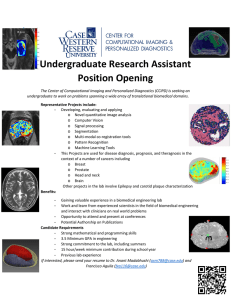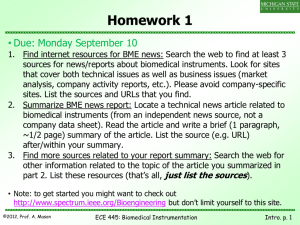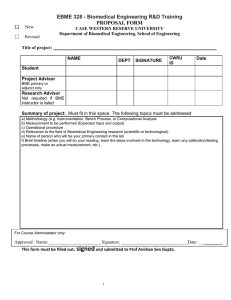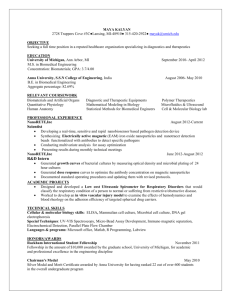BIOMEDICAL E N G I N E E R I N... M I C H I G A N ... S UM M E R 2 01 2
advertisement
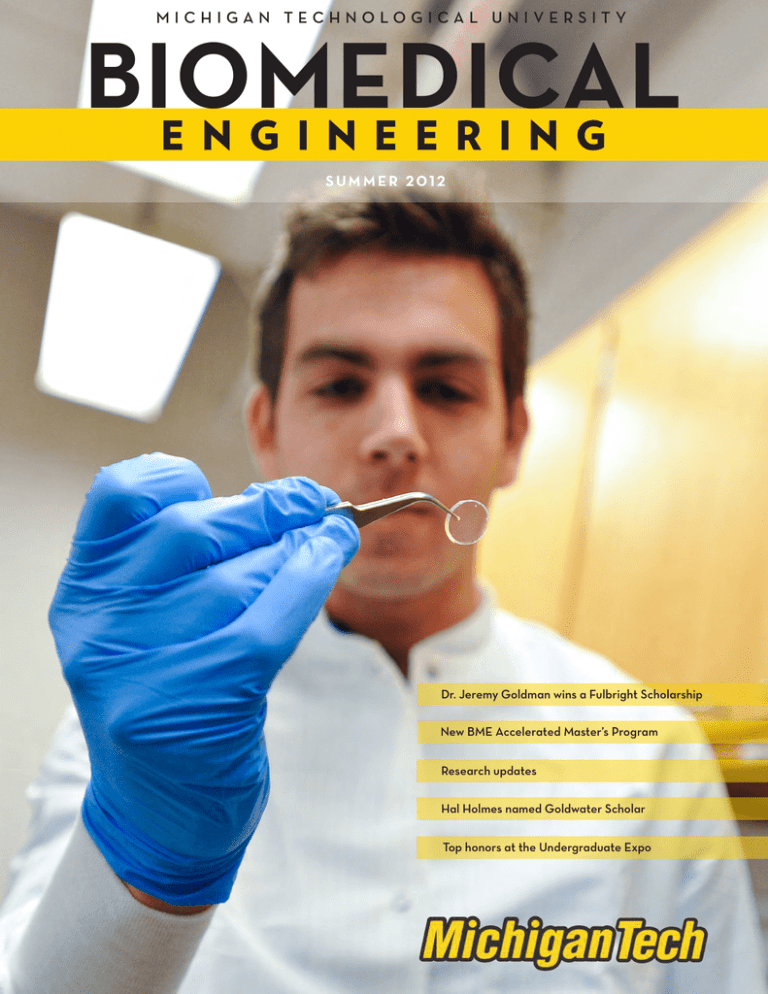
MICHIGAN TECHNOLOGICAL UNIVERSITY BIOMEDICAL E N GI N EER I N G SUMMER 2012 Dr. Jeremy Goldman wins a Fulbright Scholarship New BME Accelerated Master’s Program Hal Holmes named Goldwater Scholar Top honors at the Undergraduate Expo BIOMEDICAL ENGINEERING Research updates 1 LETTER FROM THE CHAIR Dear Friends and Colleagues, IT HAS BEEN A DYNAMIC COUPLE OF YEARS for the Department of Biomedical Engineer- ing at Michigan Tech. We have recruited four new faculty members, including myself. In August of this year, yet another assistant professor will join our team. This means that one half of the BME faculty are new to Michigan Tech. We are in the final stages of revising our course requirements to develop a modern undergraduate curriculum—one that will focus on hands-on and applied aspects of biomedical engineering in a manner that is responsive to the needs of the biomedical industry sector while also preparing students for further education in engineering, life sciences, or health and dental professions. Teaching much of the core engineering curriculum within the BME department will immerse our students in the unique demands of engineering for the life and health sciences starting their freshman year. By bringing much of our curriculum in-house, a vibrant biomedical engineering student community will develop, bound together by the distinctive skill sets possessed by biomedical engineers. This is an appropriate place to note that undergraduate enrollment continues to climb. The fall 2012 semester should have us at nearly 300 undergraduate BME majors. Based on our historic rate of increase, the department should enroll in excess of 300 undergraduate students in fall 2013. At the graduate level, our PhD program is gaining strength as we continue to find exciting opportunities for funded doctoral research. Our ability to offer a wider variety of graduate-level course offerings is also increasing with the addition of new faculty. We have developed new master’s degree programs in biomedical engineering, including an accelerated master’s degree in which our best undergraduate students can earn an MS in BME with only a single year of study beyond their BS degree. Our research programs are looking stronger than ever. As our new faculty establish their research programs, and our more established faculty continue to grow theirs, we expect great things to come out of our research laboratories. Research in the department focuses on four major areas: tissue engineering and biomaterials; biosensors and biomedical instrumentation; biomedical optics and imaging; and cardiovascular engineering. We have formulated a long-term strategic plan to help guide continued growth of the department over the next decade and have begun implementing shorter-term tactical plans to help us reach our long-term strategic goals. All of these developments are aimed at achieving our singular vision of being a high-quality, research-driven biomedical engineering department with excellence in both undergraduate and graduate education. We are well on our way to seeing this vision become a reality. Best Wishes, MICHIGAN TECH Sean J. Kirkpatrick, PhD Department Chair 2 The Department of Biomedical Engineering at Michigan Tech is among the world’s leaders in providing quality education and research. As of June 2012, we have ten faculty, two staff, nineteen graduate students, and close to 300 undergraduate students. We are housed in the Mineral and Materials Engineering Building at the center of Michigan Tech’s campus in Houghton. We offer programs leading to the Bachelor of Science, Master of Science, and Doctor of Philosophy (PhD) in Biomedical Engineering. OUR MISSION The Department of Biomedical Engineering serves the University, the community, and the biomedical engineering profession through education, research, and design activities. The department offers innovative educational programs that integrate biological sciences and engineering, and apply engineering tools, methods, and practices to solve problems in biology and medicine. Graduates of our programs are highly skilled biomedical engineers who understand the ethical, social, and economic implications of their work. BIOMEDICAL ENGINEERING FACULT Y NILOY CHOUDHURY, PhD University of Connecticut Optical coherence tomography BRUCE LEE, PhD University of Wisconsin, Madison Bioadhesives MEGAN FROST, PhD University of Michigan Nitric oxide releasing polymers, implantable sensors MICHAEL NEUMAN, PhD, MD Case Institute of Technology Biomedial sensor and instrumentation JEREMY GOLDMAN, PhD Northwestern University Lymphatic and blood vascular systems KEAT GHEE ONG, PhD University of Kentucky Biosensors, passive implantable sensors JINGFENG JIANG, PhD University of Kansas Biomechanics and biomedical imaging RUPAK RAJACHAR, PhD University of Michigan Biomineralization in vascular and bone-related cell types and tissues SEAN KIRKPATRICK, PhD University of Miami Biomedical optics, lasers, and imaging FENG ZHAO, PhD Duke University Tissue engineering BIOMEDICAL ENGINEERING ABOUT THE DEPARTMENT 3 NEW FACULT Y MICHIGAN TECH NILOY CHOUDHURY Niloy Choudhury joins the faculty as assistant professor. He comes to Michigan Tech from the Oregon Health & Science University. He holds a PhD in Physics from the University of Connecticut and an MS and BS in Physics from the University of Delhi. He also did postdoctoral research at the Oregon Health & Science University. Choudhury’s research interest is in biomedical optics, and in developing optical instruments for noninvasive biomedical research and diagnosis. He has published in Nature Neuroscience and PLoS, and other journals. He is an active member of SPIE. 4 JINGFENG JIANG Jingfeng Jiang will join the faculty in August 2012 as an assistant professor. He comes to Michigan Tech from the University of Wisconsin-Madison. He holds a PhD in Civil Engineering and an MS in Computer Science from the University of Kansas, as well as an MS in Structural Engineering and a BS in Civil Engineering from Zhejiang University. Jiang’s research interests straddle biomechanics and biomedical imaging. He is actively developing imagebased computational tools for easily transforming raw biomedical imaging data into simple but clinically/ biologically relevant biomechanical parameters of soft tissue pathologies and blood flow characteristics. He has published in Physics in Medicine and Biology and Medical Physics. He is a member of IEEE and ASME. BRUCE LEE Bruce Lee joins the faculty as assistant professor. He comes to Michigan Tech from the Kensey Nash Corp., which acquired the start-up company Lee help to found, Nerites Corporation, in 2011. He holds a PhD and MS in Biomedical Engineering from Northwestern University and a BS in Chemical Engineering from Cornell University. Lee’s research interests are focused on applying biologically inspired molecular designs for developing advanced functional biomaterials for biomedical applications. Lee has been published in Biomacromolecules, the Journal of the American Chemical Society and Analytical Chemistry. He is a member of the Society for Biomaterials, the American Chemical Society, the Adhesion Society, and the Material Research Society. FENG ZHAO Feng Zhao joins the faculty as assistant professor. She comes to Michigan Tech from Duke University. She holds a PhD in Biomedical Engineering and an MS in Material Science from Tianjin University and a BS in Polymer Chemical Engineering from Nanjing University. Zhao’s research focuses on the use of adult mesenchymal stem cells for cardiovascular tissue engineering with a particular emphasis on small diameter vessels and heart valves. Zhao has been published in Molecular Therapy, Biomaterials, and the Journal of Cellular Physiology, among others. She is a member of the Tissue Engineering Society International and the Biomedical Engineering Society. HAL HOLMES NAMED GOLDWATER SCHOLAR H al Holmes, a third-year student in biomedical and electrical engineering, has won a prestigious Goldwater Scholarship, awarded by the Barry M. Goldwater Scholarship and Excellence in Education Foundation. This is the third Goldwater Scholarship won by BME students. Previous recipients were Eli Vlaisavljevich (2009) and Jared Cregg (2008). Goldwater scholarships—established by Congress to honor the late Senator Barry M. Goldwater—are based on academic merit, research experience and intent to pursue a career in science, engineering or mathematics. The purpose of the program is to provide a continuing source of highly qualified scientists, mathematicians, and engineers by awarding scholarships to college students who intend to pursue careers in these fields. Colleges and universities nominate students for the scholarships, which cover up to $7,500 in tuition and fees. Holmes is the eighth Michigan Tech student to win a Goldwater Scholarship. Holmes has published a peerreviewed paper in the journal Biosensors and was chosen to give a podium presentation at the Biomedical Engineering Society annual meeting in 2011. He also won the Undergraduate Grand Award at the 2011 Graduate Research Forum. Serving as president of Circle K International’s campus chapter, Holmes also was community service chair for the Biomedical Engineering Society and a Housing and Residential Life resident assistant. After he completes his bachelor’s degree, Holmes plans to earn a doctorate in biomedical engineering. Rupak Rajachar, assistant professor of biomedical engineering and Holmes’ Hal Holmes advisor, described the scholarship winner: “Hal is the type of student that defines our program—technically strong, results driven, and service oriented both to his profession and community. Not only is he an exemplary student, more importantly he is an exceptional person with the maturity, temperament, and attitude to be a gifted engineer and a worthy representative of the Goldwater Scholarship.” The Goldwater Scholarship and Excellence in Education Foundation received 1,123 nominations this year and awarded 282 scholarships. ON THE ROAD TO HAIFA—JEREMY GOLDMAN WINS A FULBRIGHT Jeremy Goldman termine their suitability for manufacturing them into stents, working with Associate Professor Jaroslaw Drelich and graduate student Patrick Bowen, both in Michigan Tech’s Department of Materials Science and Engineering. The Fulbright Program is the flagship international educational exchange program sponsored by the US Government and is designed to increase mutual understanding be- Pure magnesium metal before implantation and then after spending 3 weeks and 7 weeks in an artery. Visible is the corrosion process that dissolves the metal inside the artery. tween the people of the United States and the people of other countries. Recipients of Fulbright grants are selected on the basis of academic or professional achievement, as well as demonstrated leadership potential in their fields. BIOMEDICAL ENGINEERING A ssociate Professor Jeremy Goldman has been awarded a 2012-2013 Fulbright Scholarship. He will depart in October for six months of research at the Technion Institute of Technology in Haifa, Israel. Goldman will be working in the Department of Materials Engineering with Professor Menachem Bamberger, a world leader in developing magnesium alloys. The two will collaborate on the development of novel magnesium alloys for bioabsorable stents. “The goal is to produce a biocompatible magnesium alloy that resists corrosion so that it remains present and mechanically strong for 6 to 9 months in the artery,” Goldman explains. “The alloys that we develop will be brought back to Michigan Tech,” says Goldman. He plans to implant them in order to analyze the materials and de- 5 NEW MASTER’S DEGREE PROGRAMS T o complement existing BS and PhD degrees, Michigan Tech now offers a Master of Science in Biomedical Engineering. The Department of Biomedical Engineering now offers a traditional, thesis-based master’s degree, a course work-only option, and an accelerated MS option open only to students enrolled in Michigan Tech’s undergraduate BME program. At the national level, there is a burgeoning demand for graduates with a master’s education in biomedical engineering. “With a strong knowledge base in engineering and life sciences, students can now position themselves to succeed in an increasingly demanding job market,” notes professor Sean Kirkpatrick, chair of the Department of Biomedical Engineering. “The addition of this new degree offering completes the array of educational opportunities available to students interested in biomedical engineering, builds our growing graduate educational presence, and offers the education students need to be successful in both industry and government careers.” Acclerated Master’s Degree—Earn a Bachelor’s and a Master’s in Five Years STUDENTS AT MICHIGAN TECH can now get on the fast track to a MICHIGAN TECH career in the biomedical industry or advanced studies in biomedical engineering. The Biomedical Engineering Accelerated Master’s program allows students to earn both a Bachelor of Science and a Master of Science in Biomedical Engineering in as little as ten semesters of full-time course work, which translates to five academic years. “The demand for master’s degrees is growing in industry,” says Michigan Tech Provost Max Seel, “and we are trying to be proactive in meeting that need. We want students to know that at Michigan Tech, you can go straight through to a master’s degree.” The Biomedical Engineering Accelerated Master’s program offers a course work-only degree option that is designed for highly motivated students who wish to enter a mid-level position in industry upon graduation or pursue doctoral studies in biomedical engineering. The new program provides the competitive edge of an advanced degree in just two semesters—one academic year—of study beyond a bachelor’s degree. Students accepted into the program begin graduate course work in the final year of undergraduate study. Students must earn 30 credit hours at the 4000 level or higher for the Master of Science in Biomedical Engineering; however, up to 6 of these credit hours taken as an undergraduate student can be applied toward both the Bachelor of Science and Master of Science degrees. 6 FACULTY RESEARCH UPDATES RUPAK RAJACHAR: Cells adherent to bone regenerative vaporized reactive coating NILOY CHOUDHURY: Motion paths of singular points (optical vortices) in the phase of light scattered from rapidly moving particles (left) and more slowly moving particles (right). FENG ZHAO: Morphology of a human mesenchymal stem cell sheet. F-actin (red) and cell nuclei (blue) shows cells very well aligned in the cell sheet. RUPAK RAJACHAR Rupak Rajachar’s research is focused on developing novel materials and mechanical systems to address fundamental issues in tissue engineering, specifically cellular responses to micron and submicron level changes in the chemical and physical environment. NILOY CHOUDHURY Niloy Choudhury and his group focus on developing novel coherent imaging techniques to reveal near-cellular level structural details of biological structures in vivo and for the noninvasive quantification of blood flow and other biological motions. Recent Publication: Chen, F., Zha, D., Fridberger, A., Zheng, J., Choudhury, N., Jacques, S.L., et al. “A differentially amplified motion in the ear for near-threshold sound detection.” Nat Neurosci. [10.1038/nn.2827]. 2011;14(6):770-4. FENG ZHAO Feng Zhao’s research focuses on developing novel strategies for the regeneration of human tissues and treatment of human diseases using adult stem cells. Zhao’s team is currently tissue engineering completely biological and mechanically strong vascular grafts that can be potentially used for a variety of clinical applications, including coronary artery and peripheral artery bypass surgeries. Recent Publication: Ho, Y.P., Grigsby, C.L., Zhao, F., Leong, K.W. “Tuning Physical Properties of Nanocomplexes through Microfluidics-Assisted Confinement.” Nano Letters 2011,11:2178-2182. MEGAN FROST: Retinal epithelial (ARPE-19) cell morphology changes observed when cells are exposed to (A) low level of NO; (B) high level of NO, and (C) control not exposed to NO. MEGAN FROST Megan Frost’s research group has developed a second generation controlled nitric oxide (NO) releasing cell culture platform that is currently being used to investigate the response of dorsal root ganglion nerves and retinal epithelial cells to varied levels of nitric oxide. They have also developed pH sensor chemistry that is compatible with NO release that will be used in the fabrication of an intravascular blood gas sensor. Frost’s team also continues to develop novel polymeric materials (PVC, PDMS) that release NO in response to light. Recent Publication: Gierke, G.E., Neilsen, M. and Frost, M.C. “S-Nitroso-N-acetyl-D-penicillamine covalently linked to polydimethylsiloxane (SNAP–PDMS) for use as a controlled photoinitiated nitric oxide release polymer.” Science and Technology of Advanced Materials, 2011, 12 055007. BIOMEDICAL ENGINEERING Recent Publication: Holmes, H.R., Tan, E.L., Ong, K.G., Rajachar, R.M, “Fabrication of biocompatible, vibrational magnetoelastic materials for controlling cellular adhesion.” Biosensors 2012, 2, 57-69. 7 FACULTY RESEARCH UPDATES (continued) MICHAEL NEUMAN: Wearable energy harvester JEREMY GOLDMAN (right): Mouse foreleg in cross section following excision of lymph nodes. Green structures identified by yellow arrows are lymphatic vessels, red identifies lymphatic fluid, and blue circles are cell nuclei. Normally lymph fluid is found within the lymph vessels. Following damage to the lymph nodes, lymph fluid is found outside of the vessels. MICHAEL R. NEUMAN Michael R. Neuman’s research involves the application of microfabrication technology to the development of biomedical sensors and instrumentation for clinical applications. Recent examples are thin-film strain gauges for the dynamic measurement of angle of finger joints and chewing motion of the jaw, in collaboration with Prof. Edward Sazonov of the University of Alabama, Tuscaloosa. Other work in collaboration with Prof. Robert Warrington and recent PhD graduate, Prof. Edwar Romero of Turabo University in Puerto Rico involves development of energy harvesting devices for use on the human body. Recent Publication: Neuman, M.R., Baura, G.D., Meldrum, S., Soykan, O., Valentinuzzi, M.E., Leder, R.S., Micera, S., Zhang, Y.T. “Advances in Medical Devices and Medical Electronics.” Proceedings of the IEEE, vol. 100, no. Special Centennial Issue, pp.1537-1550, May 13, 2012. JEREMY GOLDMAN Jeremy Goldman’s group has been working to clarify the adaptations that occur in the microcirculation and interstitial environment following lymphatic injury so that we can develop therapies to treat secondary lymphedema, which is often a consequence of surgery to treat breast cancer. MICHIGAN TECH Recent Publication: Mendez, U., Brown, E., Ongstad, E., Slis, J., and Goldman, J. “Functional Recovery of Fluid Drainage Precedes Lymphangiogenesis in Acute Murine Foreleg Lymphedema.” Am J Physiol Heart Circ Physiol. March 16, 2012. [Epub ahead of print]. 8 BRUCE LEE Bruce Lee’s research is focused on applying biologically-inspired molecular designs with chemistry, polymer engineering and materials science principles in developing advanced and functional biomaterials for various biomedical applica- tions. He is currently incorporating adhesive moieties found in mussel adhesive proteins to create nanocomposite hydrogels with improved mechanical properties. These materials can potentially be used to repair load-bearing connective tissues. Recent Publication: Lee, B.P., Messersmith, P.B., Israelachvili, J.N., Waite, J.H. “Mussel-Inspired Adhesives and Coatings.” Annual Review of Materials Research. 2011;41:99-132. KEAT GHEE ONG Keat Ghee Ong’s research group focuses on the development of wireless, passive sensor technologies for biomedical applications. Recently, the lab has developed two types of implantable pressure sensors for potential use in real-time, in vivo monitoring of pressure and stress at abdominal aortic aneurysm and sphincter of Oddi. A wireless pressure mapping system was also developed for monitoring contact forces at the stump-socket interface of lower-limb prosthesis, as well as forces on the plastic insert of a knee implant. Recent Publication: Ee Lim Tan, Andrew J. DeRouin, Brandon D. Pereles, Keat Ghee Ong. “Design, fabrication, and implementation of a wireless, passive implantable pressure sensor based on magnetic higher-order harmonic fields.” Biosensors, vol. 1, pp. 134-152, 2011. SEAN J. KIRKPATRICK Sean J. Kirkpatrick’s laboratory focuses on understanding biological dynamics through the use of coherent light techniques. Current areas of focus include biological particle sizing, non-invasive measurements of blood and other fluid flows, optical elastography, and cellular dynamics. Recent Publication: Kirkpatrick, Sean J., Khaksari, K., Thomas, D., and Duncan, D.D. “Optical vortex behavior in dynamic speckle fields.” Journal of Biomedical Optics, 17(5):050504-1, 2012. BRUCE LEE: Adhesion testing of a bioadhesive hydrogel, which incorporates adhesive moieties from mussel adhesive proteins. Want to make a gift to the Department of Biomedical Engineering? KEAT GHEE ONG: An implantable pressure sensor based on the signal change of a magnetically soft material. ALTHOUGH Michigan Tech is a state-assisted institution, it receives less than one-third of its funding from state appropriations. Your gift helps keep our department on the cutting edge. There are two ways to give: • Use Michigan Tech’s online gift form at www.mtf.mtu.edu/gift. • Call the Michigan Tech Fund at 906-487-2310. Many, many thanks! SEAN KIRKPATRICK: Motion paths of singular points (optical vortices) in the phase of light scattered from rapidly moving particles (top) and more slowly moving particles (bottom). BIOMEDICAL ENGINEERING In order to make sure 100 percent of your gift goes to the Department of Biomedical Engineering, please specify the Biomedical Enhancement Support Fund 1454. 9 BME TAKES TOP SENIOR DESIGN HONORS AT UNDERGRADUATE EXPO M MICHIGAN TECH TOP Fluorescent polymer-coated wires for degradation characterization (Bioabsorbable Polymer-Coated Metal Stent Degradation Simulation Design). MIDDLE Arjun, Katy, and Doug in the lab (IBV Enterprise). BOTTOM Prototype (Portage Health Noise Monitoring Device). 10 ore than fifty Senior Design and two dozen Enterprise teams converged on the Memorial Union during the Michigan Tech Undergraduate Expo in April, and their projects were as impressive as they were varied. The Union filled up early as crowds, judges, media, and local school children checked out the inventive creativity on display. A student team from the Department of Biomedical Engineering, Bioabsorbable PolymerCoated Metal Stent Degradation Simulation Design, took first place in the Senior Design category. The team devised a better way to check for the degrading of stents, which are inserted into arteries, both in vitro (in the lab) and in vivo (in the living subject). Team members were Kristina Price, Brendan Daun, Thomas Faulkner, Erin Larson, Derek Yesmunt, David Strobel, Kelsey Waugh, and Matt Gardeski. The team was sponsored by Boston Scientific and advised by Associate Professor Jeremy Goldman and Materials Science and Engineering Associate Professor Jaroslaw Drelich. Portage Health Noise Monitoring Device, an ingenious invention to warn of unacceptable noise levels in a hospital setting, won third place in the Senior Design category at the Expo. Team members were J. Ethan Lynch, Shaubhik Bhattacharjee, Trent Jansen, J. Nathan Willemstein, and Lynn Giesler. Their advisor was Professor Michael Neuman. Biomedical engineering students also earned Honorable Mentions at the Expo on multidisciplinary teams sponsored by the Department of Mechanical Engineering. Professor Gregory Odegaard advised both teams. The first is dedicated to the improvement of the Jaipur Foot, a prosthetic used for low-income patients. BME team members were Stefanie Bass and Allison Lebovsky. The second involved the design a cost-optimized prosthetic knee joint for transfemoral amputees in India that can be manufactured with local materials and infrastructure. BME team members were Elizabeth Anne Dancy and Kelsy Ryskamp. For more information and photos of all the teams, visit www.expo.mtu.edu. 2012 UNDERGRADUATE EXPO TEAMS SENIOR DESIGN Bioabsorbable Polymer-Coated Metal Stent Degradation Simulation Design The team developed low-cost, simplified, and time-effective methods for characterizing the degradation behavior of different polymers. Parallel in vitro and in vivo methods exploited the properties of fluorescent molecules and utilized simple implant geometries to characterize degradation rates and behavior. Sponsored by Boston Scientific Portage Health Noise-Monitoring Device The team developed a sound-level alarm to be incorporated at Portage Health in Hancock to alert when sound levels reach a decibel level over a set threshold. Advised by Portage Health In Vivo Sensor System to Measure Environmental Conditions on Implantable Medical Devices The team developed a wireless device that provides feedback for assessing in vivo conditions for different implant situations. Sponsored by Boston Scientific Minimally Invasive Thoracic Fixation System The team sought to reliably and effectively fixate implantable devices inside the body, determining that secure fixation to a more mechanically stable site in the thoracic cavity may reduce device motion and thereby reduce signal noise. Sponsored by Medtronic Development of a Hydrophilic/Hydrophobic Interface The team fabricated a polymer layer to interface with hydrophilic and hydrophobic materials simultaneously This coating can be placed over a base layer, such as polypropylene, silicon rubber, or stainless steel, that will allow for good adhesion with a collagen layer, which will in turn promote cell attachment and growth. Sponsored by the Department of Biomedical Engineering Modeling and Design of a Clavicle Bone-Plate ENTERPRISE International Business Ventures—Biomedical Solutions for Global Markets International Business Ventures (IBV) creates biomedical solutions for global markets. Currently the team is working on an Infant Heart Annunciator, to be used in the Third World, and a low-cost Pandemic Ventilator. Sponsored by J. Edgar McAllister Foundation and HEYER America TOP Applying collagen layer to silicon rubber (Development of a Hydrophilic/ Hydrophobic Interface) MIDDLE Clavicle and plate in UGNX (Modeling and Design of a Clavicle Bone-Plate) BOTTOM Prototype (Portage Health Noise Monitoring Device) BIOMEDICAL ENGINEERING The team’s final plate design was shown to balance clavicular stresses due to the biomechanical loading of daily activities, as well as provide structural support for various fracture geometries in the clavicle. Sponsored by Zimmer Inc. 11 Department of Biomedical Engineering 309 Minerals & Materials Engineering Bldg 1400 Townsend Drive Houghton, MI 49931 P. 906-487-2772 F: 906-487-1717 E: biomed@mtu.edu www.mtu.edu/biomedical MICHIGAN TECH Michigan Tech is an equal opportunity educational institution/equal opportunity employer. 12 www.mtu.edu/biomedical
